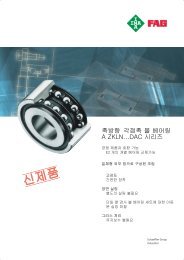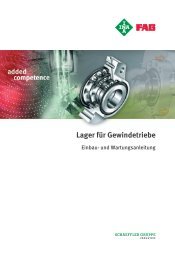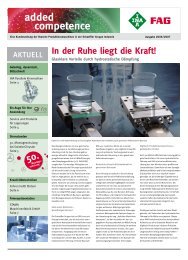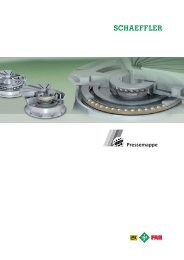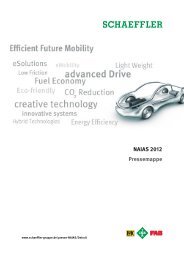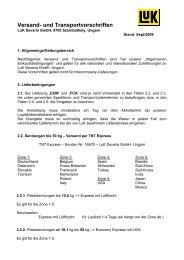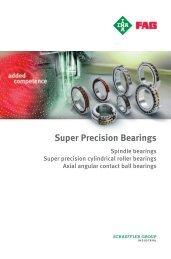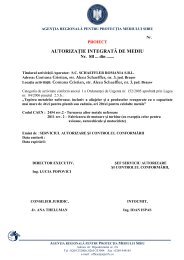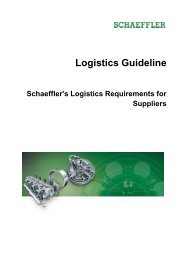26 - Schaeffler Group
26 - Schaeffler Group
26 - Schaeffler Group
You also want an ePaper? Increase the reach of your titles
YUMPU automatically turns print PDFs into web optimized ePapers that Google loves.
<strong>26</strong> Chassis<br />
Range 500-1100 Nm<br />
87.9 mm<br />
251.3 mm<br />
220-282 mm<br />
54.9 mm<br />
108.5 mm<br />
80-100 mm 50-62 mm 90-120 mm<br />
Range 1000-1800 Nm<br />
Approx. 80 mm<br />
70-100 mm<br />
Figure 20 Modular system for roll stabilizati on<br />
Electromechanical<br />
damper (electric<br />
damper)<br />
Approx. 250 mm<br />
220-285 mm<br />
Approx. 60 mm<br />
55-65 mm<br />
At the beginning of the 1990s, the idea of using<br />
the energy lost when damping a vehicle lead to<br />
the concept of operati ng an electric motor (BLDC)<br />
as a generator using a ball screw drive to convert<br />
the verti cal movement of the wheel into a rotati<br />
onal movement of the rotor and, thus, to the<br />
regenerati on of the damper energy [12].<br />
The electric damper also offers the prerequisites<br />
for optimizing damper characteristics that are<br />
beyond the scope of the hydraulic system and<br />
provides the basis for realizing a semi-active suspension<br />
system. It can make a contribution both<br />
to improving driving comfort and increasing the<br />
performance of driving dynamics. Electric damping<br />
has been blighted in the past by the failure of<br />
Approx. 110 mm<br />
95-120 mm<br />
97 mm<br />
Approx. 107 mm<br />
developers who have tried to use linear motors.<br />
The intrinsic energy requirements of these motors<br />
exceed the damping energy many times and<br />
the design space requirements are critical.<br />
The system proposals by Michelin und Bose,<br />
which have been presented in the trade press, are<br />
certainly well known. But they are complex and/<br />
or cannot be integrated in the available design<br />
space. Alongside the unfavorable cost-benefi t rati<br />
o of well-known systems, other requirements<br />
such as the overload capability and the response<br />
to low excitati on has prevented further development<br />
in this area. The unfavorable results have<br />
lead to electric damping being generally regarded<br />
as negati ve.<br />
<strong>Schaeffler</strong> is developing a damper which will fit<br />
in the available design space of a hydraulic<br />
damper, and has a better cost-benefit ratio than<br />
existing active dampers, and an improved overload<br />
capability. This damper is described in more<br />
detail below.<br />
Design and functi on of the<br />
Schaeffl er electric damper<br />
The basic configuration of the damper comprises<br />
a BLDC motor, a ball screw drive with bearing<br />
support and a damper tube (Figure 21). The forces<br />
introduced into the chassis follow the flow of<br />
force as shown in Figure 21.<br />
The wheel carrier and suspension strut are excited<br />
in a vertical direction by the road. This<br />
translatory motion is converted into rotary mo-<br />
Damper dimensions<br />
Length of the DC motor: 75 mm<br />
Pitch of the ball screw: 10 mm<br />
Rotor diameter: 28 mm<br />
Housing diameter: Approx. 73 mm<br />
356 Schaeffl er SYMPOSIUM 2010<br />
Schaeffl er SYMPOSIUM 2010 357<br />
Guide<br />
Bearing support<br />
Motor rotor<br />
DC ball screw drive<br />
Centrifugal drive<br />
Bearing support<br />
1 Hub<br />
2 Centrifugal weights<br />
3 Tension spring<br />
4 Brake strap<br />
5 Sealing shield<br />
33<br />
22<br />
11<br />
44<br />
4<br />
55<br />
22<br />
33<br />
73 mm<br />
75 mm<br />
Figure 21 Design of the Schaeffl er electric damper<br />
Approx. 300 mm<br />
Chassis<br />
tion in the damper and damped by the electric<br />
motor which is operated as a generator. The centrifugal<br />
brake is used to brake the rotary motion<br />
of the electric motor rotor if large impulses occur.<br />
Dimensioning of the electric<br />
damper<br />
The electric damper is dimensioned according to<br />
the characteristi c curve during compression and<br />
rebound of a hydraulic damper and the physical<br />
limits of the electric motor during generator operati<br />
on. Compression is indicate by the green line<br />
and rebound by the blue line.<br />
The performance range marked in brown in Figure<br />
22 can be covered by an electric damper. If<br />
the travel speed of the damper is approximately<br />
1000 mm/s, the electric motor goes into saturation<br />
mode and the maximum damper force is approximately<br />
2500 N. Any overloading can be reduced<br />
by means of a centrifugal brake developed<br />
by <strong>Schaeffler</strong>.<br />
Peak force in N<br />
8000<br />
Force vs. speed<br />
6000<br />
- Overload range<br />
4000<br />
- can be safeguarded by<br />
centrifugal brake<br />
2000 Se�ng range of<br />
electric damper<br />
0<br />
0 500 1000 1500 2000<br />
Maximum speed in mm/s<br />
Compression<br />
Rebound<br />
Figure 22 Characteristi c curve of a hydraulic damper<br />
and the applicati on range of an electric<br />
damper<br />
The functional equations for the damper are derived<br />
using the quarter-scale model of the vehicle.<br />
The damper element is removed from the<br />
model and replaced by an electromechanically<br />
generated force F . A<br />
Figure 23 shows the quarter-scale model of the<br />
vehicle with the relevant coordinates and symbols<br />
for compiling moti on equati ons. The actuator<br />
force is due to the behavior and acti vati on of<br />
the electromechanical system during generator<br />
operati on and is a functi on of the motor voltage.<br />
<strong>26</strong><br />
<strong>26</strong>



